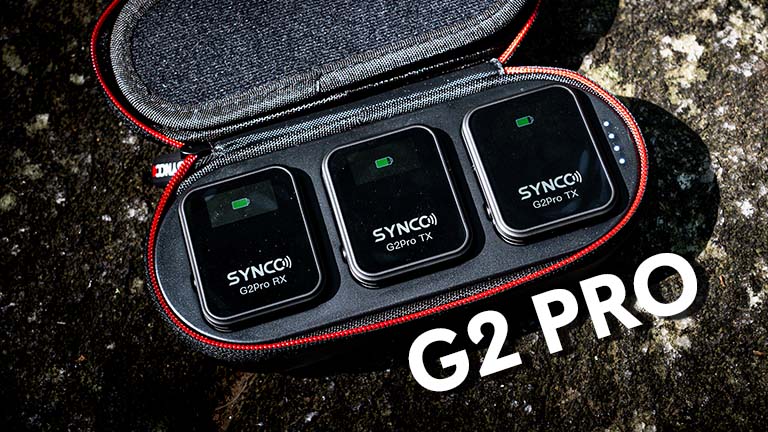Links in this post may be affiliate links. Any products purchased through affiliate links may provide a small commission which helps to support the SemiPro Tech+Gear site and YouTube channel.
The Synco G2 Pro offers a wireless solution for content creators that provides a wealth of features for an affordable price. Is the G2 Pro system a better option than the ever-popular Wireless GO II from Rode, or are there too many compromises?
The short answer is: there are compromises, it’s just a matter if they are dealbreakers for you or not. The G2 Pro system provides a lot of value for $199 (two transmitter kit), but it does not match all the features of the popular and more expensive options including the Rode Wireless GO II and the DJI mic system. The key feature missing from the G2 Pro is internal recording in the transmitters. That omission could be a dealbreaker for some creators, especially if you don’t have a secondary/dual audio setup with a separate hardwired microphone as a backup in case of wireless interference or dropouts. However if that’s not a critical feature for you, then the G2 Pro system is worth considering.
Synco G2 Pro (A2 Kit)
MSRP: $199.99
Pros
- Can use both USB & 3.5mm outputs simultaneously
- Sound quality of the built-in mic
- USB compatible with iOS & Android
- Charging case & lav mics included
Cons
- No internal recording
- USB conversion is 16-bit (vs 24-bit)
- Noise reduction sounds a bit unnatural
- Metering is wonky when lav mic is connected
Best For: Adding a wireless option to your setup as long as internal recording is not needed.
Features & Connectivity
Hardware features of the G2 Pro include:
Receiver:
- USB-C & 3.5mm output (can be used simultaneously)
- 3.5mm headphone output (not latency-free due to wireless)
- Transmitter gain control (A & B separate)
- 8hr battery life (400mAh)
- 16-bit / 48kHz output over USB
- Recording Modes: Mono, Stereo, Safety
Transmitters:
- Built-in microphone
- 3.5mm TRS input for external mics
- Freq response (built in mic): 50Hz – 20kHz
- Max SPL: 120dB
- 2.4GHz wireless transmission
- Noise reduction on/off control
- 8hr battery life (400mAh)
Kit (A2):
- Charging case with USB-C port (3400mAh)
- 2x deadcats for transmitter
- 2x lavalier microphone
- 3.5mm TRS cable
- 3.5mm TRS to TRRS cable
- USB-C to USB-C cable
The transmitters and receiver automatically charge when placed in the case and status lights inside the case indicate how much charge is left in the case. The transmitters automatically connect to the receiver when they are powered on. The noise reduction feature is controlled only by the transmitters, and the receiver does not display the status of noise reduction.
Both the USB and 3.5mm output of the receiver can be used simultaneously to send audio to a computer or mobile device and into your camera. There is no internal recording in the transmitters, so only wireless audio is available. One thing to note about the safety track recording mode is that the right track is recorded at -6dB, which is helpful, but if the gain is set excessively high by accident, this may not be “safe” enough. It’s common for safety tracks to record at -12 or even -20dB to ensure clipping is avoided. So proper gain setting, even in safety mode, is still important.
Sound Quality & User Experience
In my testing, I found the sound quality of the built-in microphone to be very good with clear detail for dialog. Positioning is important to get the best sound, as directly under your chin clipped on a crewneck and pointed upwards will result in a somewhat muffled sound. Clipped further down or to the side if possible will provide a clearer sound (watch the positioning in the video above – when directly under my chin the sound is noticeably less clear).
While the USB audio is limited to 16-bit, it still sounds a bit more full than the in-camera audio which I’ve found to be the case with nearly all 3.5mm output microphones that also have a USB output.
The user experience is very simple with the automatic connection and charging and really only 3 functions to worry about: the gain setting, the recording mode, and the noise reduction on/off. One thing to point out is that when a lavalier mic is connected (tested with multiple different lav mics), the level meters on the transmitter and receiver seem to go on overdrive. The levels show clipping even when set to the lowest setting (0), however the levels shown on my camera looked normal and there was no audible clipping or distortion in the recording. So it appears to be a display issue only and not impact actual performance.
When it came to the range testing, I was able to get consistently strong signals while testing in an open suburban area at distances up to 142m (465ft) which was the maximum distance I could test with a clear line of sight. The G2 Pro states a usable range of up to 200m, but in my opinion, even a distance of 50m from the camera is much farther away than most recording scenarios require. Where I did run into some interference and signal reliability issues was in a densely populated, urban area with a high amount of WiFi traffic. While testing around my apartment complex, the signal was still reliable up to 50m, however beyond that I ran into some signal dropouts and interference. But this is not unique to the G2 Pro – I found the same issues with the Rode Wireless GO II.
Final Thoughts
So who is the G2 Pro kit best for? I think it’s worth considering if you’re looking to add a wireless option but already have a separate external microphone to capture audio in case you run into any wireless signal issues. I would not recommend the G2 Pro (or any wireless kit without internal recording) if it’s going to be your only source of audio and you film the type of content that you only have one chance to record, such as interviews with subjects that cannot be recalled on short notice. In those scenarios, the G2 Pro is a fine option if you have a secondary microphone setup and want to add a wireless kit into the mix. If you want to simplify your audio setup without losing the safety of a backup recording, then I would suggest looking into options like the Hollyland Lark Max which, although pricier, offers internal recording and 24-bit audio.


